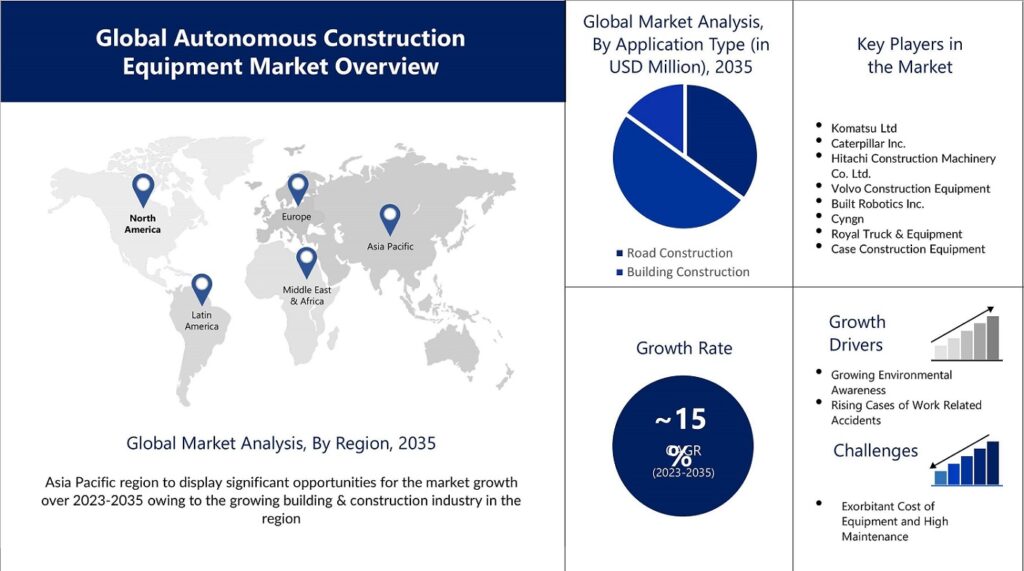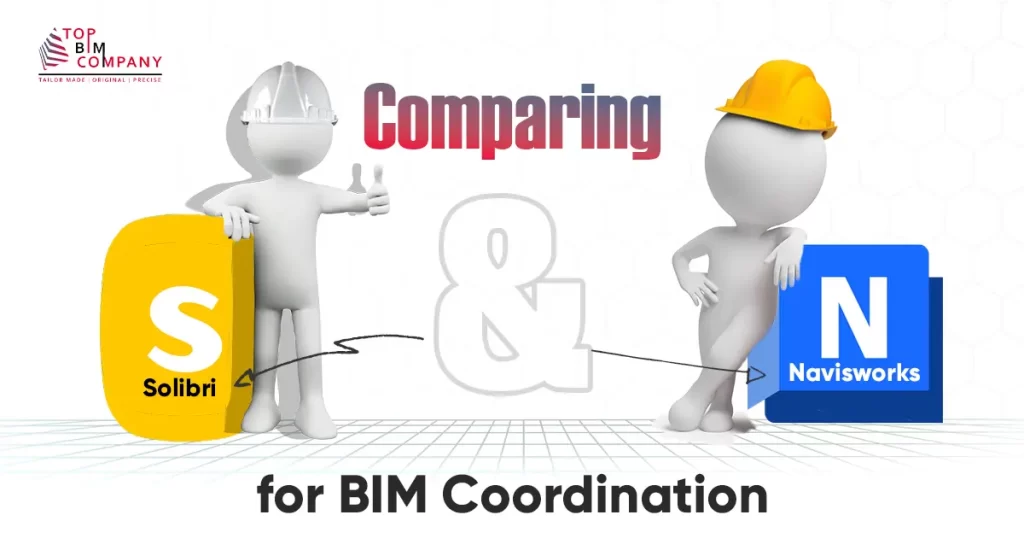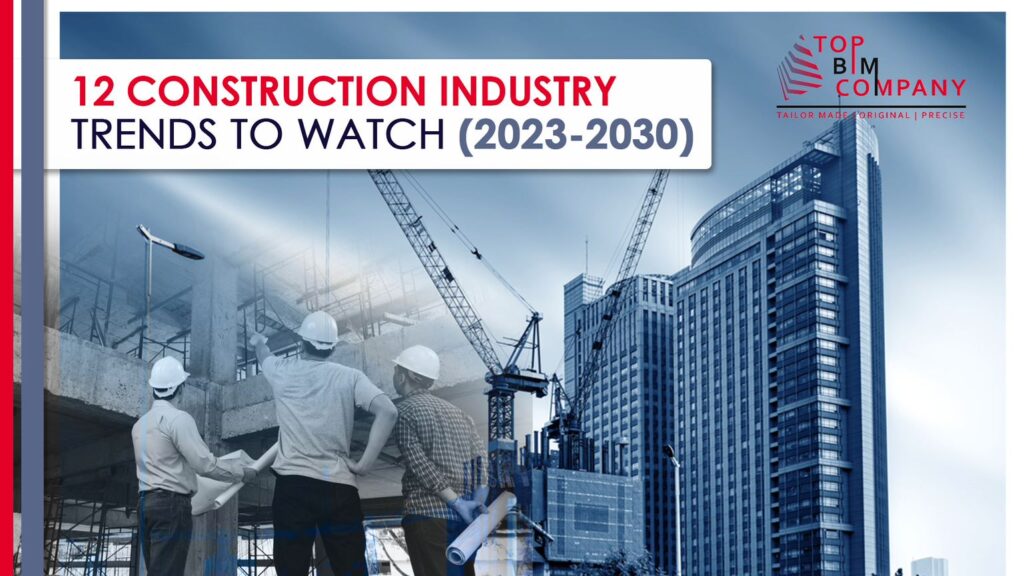
Let’s talk about construction industry trends 2023 – 2030!
Table of Contents
ToggleThe industry has been booming for a while now, but from 2023 to 2026, we’ll see some real growth. Over the predicted period, the size of the global digital transformation market is estimated to increase rapidly, with a CAGR of 21.1% between 2022 and 2027, as per Markets and Markets.
By the end of 2027, the expense of digital transformation as global construction industry outlook will increase from $594.5 billion in 2022 to $1548.9 billion.
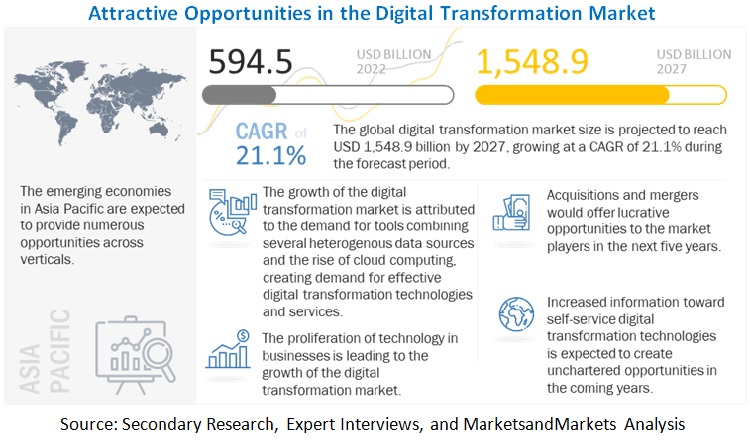
Due to increased government spending on infrastructure and rising demand for housing, the construction industry is set to really take off. And with advancements in technology like 3D printing and automation, we’re going to see some serious things happening on job sites.
But don’t get too excited – the industry still faces challenges like labor shortages and material costs.
However, with smart investments in training and a focus on sustainable building practices, the future looks bright for builders and contractors alike.
It’s time to grab your hard hat and get ready for some serious construction magic!
So, Should keep an eye on these as well:
Future of BIM Construction Trends
Innovative BIM Modeling Trends Shaping AEC Industry
Role of Autodesk in Future Construction Technology
Importance of staying up-to-date with industry trends
In today’s ever-evolving business landscape, it is crucial for professionals in the construction industry to stay up-to-date with the latest trends and advancements.
By staying informed of emerging technologies and design innovations, professionals offer their clients cutting-edge solutions that set them apart from competitors.
Additionally, having a thorough understanding of industry trends can help professionals anticipate changes in the market and adjust their strategies accordingly.
This enhances their reputation as thought leaders in the field but helps them remain competitive and adaptable to shifting market demands.
Further, staying current with industry trends showcases a commitment to ongoing learning and professional development.
Qualities highly valued by employers seeking team members are proactive problem-solvers poised for long-term success.
Ultimately, keeping abreast of industry trends equips construction professionals with the knowledge they need to deliver high-quality work while preparing them for ongoing challenges they may face down the line.
Construction Technology Trends to Watch in 2023
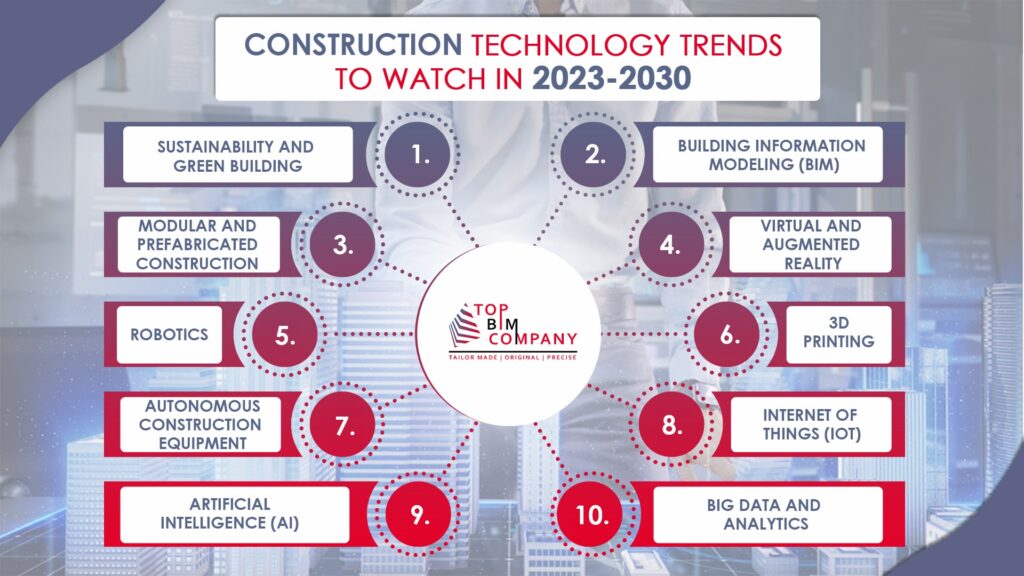
Let’s take a look at the new technology in construction industry 2023.
Applications Of BIM Technology In The Construction Industry
Automate Point Cloud To 3D Model Creation: AI And ML
1. Sustainability and Green Building
Sustainability and green building are crucial aspects of modern architecture and construction, providing a sustainable approach to building design that minimizes the negative impact on our environment.
By 2023, it is anticipated that the US green construction market will be worth $103, 08 billion.
Growing importance of sustainable practices in construction
Sustainable projects use environmentally responsible products and materials, conserve energy and water resources, reduce waste and pollution, provide healthy indoor air quality, and encourage alternative modes of transportation.
Sustainable design practices also take into account site selection, optimization of natural resources, such as sunlight and wind, in the built environment while integrating with the surrounding ecosystems.
As per industry research, to achieve the net zero by 2050 goals, the average yearly investment in energy-efficient buildings must increase to almost half a trillion dollars between 2026 and 2030.
Benefits at a glance:
- Brings positive impact on the environment
- Provides economic benefits
- Building sustainably saves money by reducing energy costs
- Creates new jobs in local communities for constructing green buildings
It’s critical that professionals across various disciplines come together to develop sustainable solutions that will guarantee a greener tomorrow.
Adoption of green building certifications and standards:
The adoption of green building certifications and standards is a critical step in promoting sustainable development in the built environment.
These tools provide guidance on how to design, construct, and operate buildings that mitigate their impact on the environment, conserve resources, and reduce carbon emissions.
The most widely used green building rating systems include LEED, BREEAM, and WELL Building Standard. Each of these certifications evaluates various aspects of a building’s sustainability performance based on criteria such as water efficiency, energy consumption, indoor air quality, materials selection, and occupant health and wellbeing.
Key Benefits:
- Optimizing Investment: By ensuring that buildings meet these rigorous standards, stakeholders can optimize their investments and achieve measurable benefits in terms of environmental stewardship, social responsibility, and economic viability.
- Advancing Sustainability: As green building continues to gain momentum globally, it is essential for professionals across the industry to embrace these certifications as fundamental tools for advancing sustainable practices in the built environment.
Building Information Modeling (BIM)
BIM statistics in construction refer to the use of Building Information Modeling (BIM) software to improve the efficiency and accuracy of construction projects. BIM has been found to reduce errors, save time, and minimize waste in the construction process.
According to a study by McGraw Hill Construction, 75% of contractors believe that using BIM results in a positive ROI (Return on Investment), while 90% of architects report improved visualization capabilities with BIM.
Also Read: Comprehensive Guide- Building information modeling (BIM)
Further, BIM adoption rates are increasing rapidly – with over 70% of contractors and architects now using it for their projects. These statistics showcase BIM’s effectiveness in improving project management and highlighting its growing popularity within the industry as more professionals recognize its benefits.
As BIM continues to develop, it provides better data analytics and insights into projects’ performance. The trend towards increased use of BIM is set to continue as developers realize its numerous benefits in improving efficiency, minimizing waste and reducing costs associated with construction projects.
The demand for BIM services is set to increase as many governments around the world adopt regulations entailing the use of BIM processes in public infrastructure projects.
Further, advancements in technology such as cloud computing, artificial intelligence (AI), and augmented reality (AR) are expected to revolutionize the way professionals create and analyze data during construction projects.
The future looks promising for the global BIM market which is projected to grow at a CAGR of over 12%, generating an estimated US$10 billion in revenue by 2026.
Increased use of BIM software for project planning and management
As per construction industry outlook for 2023, there is a significant rise in the use of Building Information Modeling for project planning and management. BIM technology provides construction teams with a detailed 3D model that includes all aspects of a project, from design to completion.
Key Benefits:
- Enables teams to identify potential issues and conflicts early on in the process
- Reduces errors and rework later on
- BIM facilitates collaboration among different stakeholders
- Generates accurate documentation that can be accessed remotely from anywhere.
Integration with other technologies such as drones and 3D printing
As industries increasingly adopt automation and innovation, drones and 3D printing have emerged as technologies that fundamentally change the way we manufacture, design and deliver products. Integration with other technologies greatly enhances their potential in a range of applications, from precision agriculture to emergency response.
Technology Integration with BIM:
- Drones with Machine Learning: Drones can be integrated with machine learning algorithms to autonomously conduct site surveys or collect data for mapping purposes.
- Drones with 3D Printing: Additionally, drones can transport 3D-printed parts or materials swiftly over long distances, particularly in hard-to-reach areas where traditional means of transport is difficult.
- 3D Printing Technology: This improves supply chain efficiency by allowing businesses to produce parts on-site, reducing transit times and costs. Integrating drones and 3D printing into existing processes enables streamlined workflows and more efficient delivery of goods and services in several industries including military defense as well as commercial manufacturing firms.
Modular and Prefabricated Construction
Modular and prefabricated construction is a growing trend in the building industry, particularly in urban areas where space is at a premium. According to industry statistics, the Global Market for Modular Construction includes a thorough analysis of the market’s size, market share, and future prospects from 2023 to 2030.

It has a 9% compound annual growth rate (CAGR). The market for modular building systems was estimated to be worth USD 137.8 billion in 2021 and is projected to reach USD 271 billion by 2030.
Growing use of off-site construction methods
- In the United States alone, the modular construction industry has seen over 40% growth in the past five years, as clients increasingly seek out cost-effective and efficient alternatives to traditional on-site building methods.
- Modular and prefabricated buildings can be completed up to 50% faster than traditional methods due to their off-site fabrication process, which allows for rapid assembly on location using standardized components.
- Additionally, prefabricated structures are often more eco-friendly as they generate less waste and require fewer resources during production compared to traditional construction methods.
Advantages of modular and prefabricated construction
Modular and prefabricated construction offers numerous advantages over traditional construction methods.
- Speed: Firstly, it minimizes build times and can be completed up to 50% faster than conventional building methods. This speed makes modular and prefab a popular choice for commercial developments that require timely project completions.
- Quality Control: Secondly, the level of quality control achieved in off-site factory conditions is superior to on-site construction as each module or component is meticulously inspected before assembly or shipment.
- Reduced wastage: Reduced waste generation during fabrication results in a more ecologically friendly method of building.
- Flexibility: Additionally, modular and prefabricated buildings are highly flexible; they can be easily disassembled or reconfigured according to changing use requirements or movement from one location to another.
- Efficiency & Cost Savings: Finally, cost savings in materials procurement, energy usage during the manufacturing process and installation efficiency make modular and prefabricated constructions more economical alternatives to traditional construction methods while considering overall lifecycle costs.
Virtual and Augmented Reality
Virtual and Augmented Reality (VR/AR) technologies have witnessed a tremendous surge in popularity, with a growing number of users seeking immersive experiences. The global VR/AR market is expected to reach $67 billion by 2024, driven primarily by rapid advancements in hardware and software technologies. As per the latest industry projections, around 42 million VR/AR devices will be in use across the world by 2025.
The gaming industry is anticipated to remain a significant application area for these technologies, accounting for approximately one-third of the total market share. Enhanced user engagement and improved learning outcomes are some other emerging use cases for VR/AR applications across education, healthcare, marketing, and retail sectors.
With an increasing emphasis on hybrid events amid the COVID-19 pandemic era and beyond, virtual conferences powered by AR/VR are predicted to emerge as a key trend in the coming years.
Use of VR and AR for design visualization and project planning:
Virtual reality (VR) and augmented reality (AR) are transforming the way designers visualize and plan their projects. Using VR and AR technologies, design teams can create immersive, interactive environments that allow them to see how their ideas will look in real life before they build them.
- Saves time & resources: This saves time and resources by identifying potential issues early on in the project lifecycle.
- Remote Collaboration: Additionally, VR and AR technologies enable designers to collaborate remotely in a virtual space. This facilitates quicker decision-making processes while reducing barriers such as distance or time zones. It gives the potential for improved collaboration and communication among stakeholders.
- Efficient Workflow: The tools have become increasingly popular in architecture, engineering, construction, and product design sectors due to their ability to create a more efficient workflow process by giving designers access to instant feedback from team members or clients. As the technology continues to improve, we can expect an even greater integration of VR and AR into design practices across multiple industries.
Autonomous Construction Equipment
Autonomous construction equipment has come a long way in recent years, with advancements in technology facilitating the development of equipment capable of operating independently, without human intervention. These machines are equipped with sensors, GPS tracking systems, and cameras that allow them to navigate and perform tasks such as digging, grading, and lifting.
According to global research by Allied Market Research, the autonomous construction equipment market is expected to grow at a compound annual growth rate of 15% from 2023 to 2035. Benefits of autonomous equipment include increased safety, improved productivity, and reduced labor costs.
However, challenges remain around compatibility with existing infrastructure and regulations governing their use. As technology continues to evolve and improve, it is likely that we will see even more innovation in autonomous construction equipment in the years ahead.
Advancements in autonomous technology for construction equipment
Advancements in autonomous technology for construction equipment have revolutionized the way we think about traditional construction methods.
Potential benefits for safety, efficiency, and productivity:
- With cutting edge features such as fully automated machinery and remote monitoring systems, construction workers can now complete tasks faster, more accurately, and with greater efficiency.
- Autonomous excavators and bulldozers are outfitted with advanced sensors and cameras that allow them to navigate any terrain with little to no human guidance.
- Additionally, drone technology has made it possible for site managers to observe the progress of construction projects in real-time from a completely remote location.
- These advancements in autonomous technology have improved worker safety on job sites and reduced costs associated with labor-intensive tasks.
Continued investment in autonomous tech is likely to bring even more innovations that will transform the face of modern-day construction indefinitely.
3D Printing
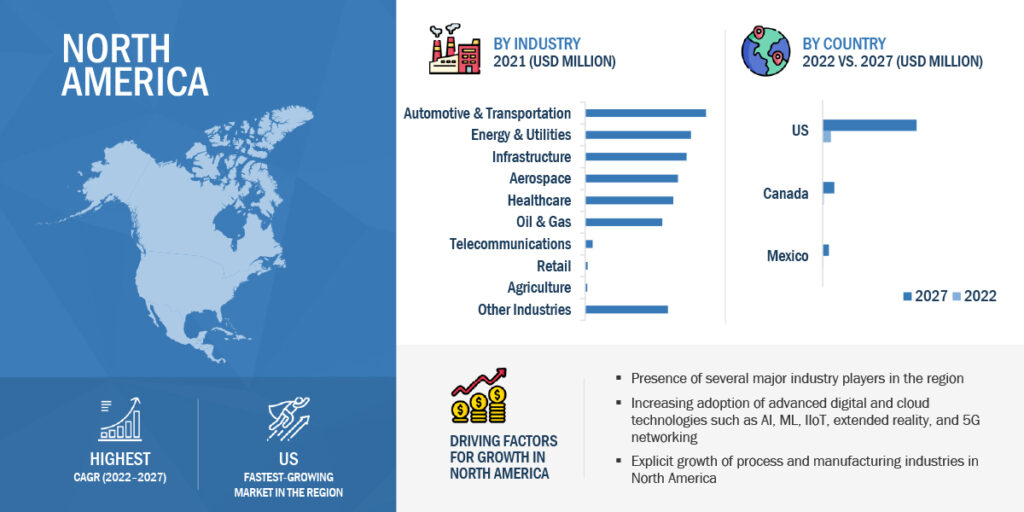
Digital twin trends are increasingly being utilized in the construction industry, with numerous benefits to project teams. The technology allows for a virtual replica of a physical asset, providing a complete digital representation of the project.
Through visualizations and simulations, digital twins can enhance communication between stakeholders and help identify potential problems before they arise that ultimately improves project performance.
As per the research conducted by Markets & Markets, by 2027, the global market for digital twins is anticipated to reach a value of USD 73.5 billion, expanding at a CAGR of about 60 %.
Growing use of 3D printing in construction
- BIM Growth: The growth is due to the increased adoption of advanced technologies such as Building Information Modeling, which enables architects and engineers to design intricate models that can be easily produced using 3D printers.
- Research & Development: Moreover, major players in the industry are investing heavily in research and development activities focused on expanding their product offerings, which will further propel the growth of this market segment. As construction companies continue to embrace this innovative technology, we can expect more impressive feats like housing projects built entirely with additive manufacturing techniques taking shape all over the world.
Key Benefits:
- Products Produced with Demand: With traditional manufacturing processes, high tooling and assembly costs often make it expensive to produce smaller quantities of products or prototypes. However, with 3D printing technology, products can be produced on demand with minimal tooling and material costs. This creates a more agile and cost-effective manufacturing process that can help businesses respond quickly to market demands and minimize overhead expenses.
- Refine Product Design Efficiently: Additionally, the ability to rapidly prototype and iterate designs using 3D printers enable designers to refine product designs more efficiently than ever before. The bottom line is that by leveraging the benefits of 3D printing for cost savings and increased efficiency, businesses can achieve greater success in the highly competitive landscape of today’s global marketplace.
Robotics
Statistics on the future of robotics in construction show that the industry is poised for significant advancements. Robotics Market size is anticipated to grow by USD 22269.7 million from 2023 to 2027 at a CAGR of 8%, with the industry having the largest market share.
This rapid growth is driven by an increasing demand for efficient building processes and new construction technologies. The adoption of robotics in the construction sector is expected to improve productivity levels whilst reducing labor costs, waste materials, and improving safety standards overall.
Further, as technology advances in areas such as AI software applications for drones or autonomous robots working alongside humans will become more viable solutions within construction projects.
- Use of robotics for bricklaying, welding, and demolition: The integration of robotics with has revolutionized the bricklaying industry. Automated systems that use precise measurements and data-driven algorithms have increased both safety and efficiency on construction sites. These robots are equipped with advanced sensors that allow them to detect obstacles and adjust accordingly, greatly reducing the risk of accidents or injuries.
- Reduced Time for Project Completion: Additionally, automated bricklaying technology has greatly reduced the time it takes to complete a project, with robots capable of laying thousands of bricks per day. The implementation of these robotic systems has increased productivity and helps builders to maintain a higher level of quality in their work by ensuring consistency in dimensions and placement.
- Potential for increased safety and efficiency: The use of robotics along with statistical analysis is paramount to improve safety and efficiency in the construction industry for bricklaying projects.
Internet of Things (IoT)
The “internet of things” (IoT) is a concept that refers to the interconnectivity of physical devices, appliances, and objects through internet-enabled sensors and software. The IoT is transforming how we interact with our surroundings, making the world more interconnected and efficient.
As per Statistia IoT devices to increase from 9.7 billion in 2020 to more than 29 billion in 2030 and China will have almost 5 billion consumers by 2030, making it the country with most of them.
Key Benefits:
- Real-time monitoring: With billions of devices connected to each other, businesses can now gather real-time information and insights from these devices to make better decisions that optimize resources, reduce waste, lower costs, and improve customer experiences.
- Potential for improved safety & efficiency: Ultimately, the Internet of Things has enormous potential for innovation and efficiency gains across multiple industries but requires thoughtful consideration regarding security measures in order to be successful long term.
Artificial Intelligence (AI)
Artificial Intelligence (AI) has become a major disruptor in the construction industry, revolutionizing processes from design and planning to project management and safety. One emerging trend is the use of AI-powered drones for surveying and collecting data on construction sites, allowing faster and more accurate inspections. With AI algorithms, data from sensors deployed on equipment are collected and analyzed to identify patterns that indicate potential problems before they occur.
This allows for timely interventions to be made before complete system failure, reducing downtime and the need for emergency repairs. As per Yahoo Finance, the size of the world’s artificial intelligence in construction market, estimated at USD 709.09 million in 2022, is projected to increase at a CAGR of 37.93% over the course of the forecast period, reaching USD 4882.79 million by 2029.
Key Benefits:
- Predictive Maintenance: The use of AI for predictive maintenance has become increasingly popular in recent years, allowing businesses to improve efficiency and reduce costs associated with equipment failures.
- Safety Monitoring: AI algorithms can also analyze this data to identify potential safety hazards, thus reducing accidents and fatalities on site.
- Automate Repetitive Tasks: Additionally, robotic technologies are being developed to automate repetitive tasks such as bricklaying or pouring concrete, resulting in increased efficiency and productivity.
- Energy Efficient Designs: Another promising application of AI is in building design optimization by using machine learning algorithms to create energy-efficient designs that reduce costs over the life cycle of a building.
As these technologies continue to evolve, the construction industry will see significant improvements in safety, efficiency, and sustainability.
Big Data and Analytics
Big data and analytics play a significant role in the development and execution of benefits plans, schedules, and risk management strategies for businesses. With the help of advanced analytical tools and techniques, companies collect and process vast amounts of data from various sources to gain insights into their employee benefits programs.
By 2027, it is anticipated that the worldwide big data market would bring in $103 billion. By 2027, big data income is anticipated to double from what it was in 2019.
- Anticipate Potential Risks: By leveraging this data to create predictive models, businesses anticipate potential risks, identify trends that may impact benefits planning, and forecast future costs effectively.
- Streamline Scheduling: Additionally, big data analysis enables organizations to streamline their scheduling processes by providing real-time information about workforce availability and productivity levels. This information empowers managers to make informed decisions quickly while reducing waste and inefficiencies.
- Stay Ahead of the Curve: Ultimately, utilizing big data analytics in benefit planning helps companies stay ahead of the curve by ensuring optimal utilization of resources while delivering better outcomes for both employees and employers alike.
Digital Twin Trends
Digital twin trends are increasingly being utilized in the construction industry, with numerous benefits to project teams. The technology allows for a virtual replica of a physical asset, providing a complete digital representation of the project.
Through visualizations and simulations, digital twins can enhance communication between stakeholders and help identify potential problems before they arise that ultimately improves project performance.
As per the research conducted by Markets & Markets, by 2027, the global market for digital twins is anticipated to reach a value of USD 73.5 billion, expanding at a CAGR of about 60 %.
Benefits of Digital Twin Technology in Construction:
- Streamlined Process: Digital twins streamline processes and workflows by providing real-time monitoring capabilities during construction activities, thereby driving efficiency and cost-effectiveness.
- Data Analysis: By analyzing data from sensors on equipment or structures, companies optimize maintenance schedules, reduce downtime, increase safety measures and minimize waste.
- Faster Build Time: Digital twins have immense potential to revolutionize the construction industry by enabling faster build times while improving quality standards through constant tracking & evaluation for accurate progress assessment.
- Boost in Productivity: Overall, increased usage of digital twins will augment productivity while commensurately reducing operational costs as well as environmental impacts in the long term
Workforce Development
Workforce development plays a critical role in addressing the shortage of skilled workers in construction. By investing in training and education programs for current and potential construction workers, companies can cultivate a pool of qualified employees who are capable of carrying out complex and demanding building projects.
As per Emeritus.org 90% of individuals, according to Indeed research, think that how we feel at work counts, yet only 49% believe that their organization is committed to tracking and enhancing well-being.
Importance of investing in workforce training & development:
- Improved Efficiency: Skilled workers improve efficiency and productivity on job sites, reducing project costs and timelines while ensuring high-quality standards are met.
- Diversify Construction Industry: Workforce development helps to diversify the construction industry by attracting more women and people from underrepresented communities into the field.
- Meeting demand of skilled workers: Ultimately, investing in workforce development is an essential component of meeting the ongoing demand for skilled labor within the construction sector.
Conclusion
Importance of staying informed and adapting to trends for construction:
In today’s rapidly evolving business landscape, staying informed and adaptable to industry changes is critical for professionals to remain competitive and relevant in their respective fields. Without an ongoing commitment to learning, improvement, and development of new skills, professionals cannot meet the challenges of changing market trends or shifting consumer demands.
Staying informed helps you stay on top of emerging technologies or innovative practices as well as make informed decisions by providing data-driven insights into various aspects of your industry.
Adaptability allows you to pivot quickly when circumstances change, take advantage of new opportunities or navigate unforeseen challenges with agility and ease.
Thus, developing a habit of continuous learning and adaptation can help professionals sharpen their skill set and achieve greater success, while driving innovation within the industry as a whole.
Further Reading:
- Revolutionizing Building Construction 3D Laser Scanning Technology
- Innovative BIM Trends Shaping AEC Industry
- Digital Twinning For Smart Facility Management

Contact our expert BIM engineers today to consult
To know more about how we can help bring your project by implementing sustainable BIM solutions
Our Services
Latest Post
Get A Free Quote
BIM Construction is the Future
Building information modeling (BIM) is the future of building design and construction. Get in touch with our BIM Experts.

